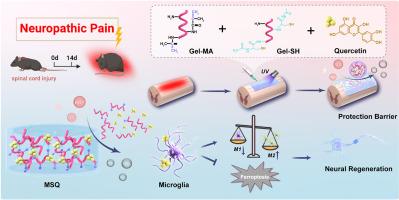可注射ROS稳态保护水凝胶,通过Nrf2/Slc7a11/Gpx4抑制小胶质细胞铁凋亡,减轻神经性疼痛,促进脊髓损伤修复
IF 11.9
1区 生物学
Q1 BIOCHEMISTRY & MOLECULAR BIOLOGY
引用次数: 0
摘要
由于持续的神经炎症和氧化应激,脊髓损伤(SCI)引起的神经性疼痛(NP)仍然是一个主要的临床挑战。我们开发了一种可注射的甲基丙烯酸和硫代明胶水凝胶,负载槲皮素(MSQ),协同清除活性氧(ROS),抑制小胶质细胞铁凋亡,以减轻NP和神经修复。MSQ水凝胶表现出快速的光交联,持续的槲皮素释放,以及通过巯基和槲皮素清除活性氧的能力,维持细胞内氧化还原稳态。MSQ通过上调Nrf2表达,促进其核易位,激活Slc7a11/Gpx4通路,从而减少脂质过氧化和炎症细胞因子释放,从而减轻lps诱导的BV2小胶质细胞铁凋亡。网络药理学和分子动力学模拟证实槲皮素与Nrf2的高亲和力结合。在小鼠脊髓损伤模型中,MSQ植入可显著减少损伤面积,抑制小胶质细胞铁凋亡,降低促炎介质(TNFα, IL-1β, IL-6),同时提高神经元存活(Nissl/NeuN+细胞)和轴突再生(MAP2/5-HT+表达)。运动功能恢复分析显示,msq治疗小鼠的BMS评分、步态规律性和机械/热痛阈值均有所改善。本研究强调MSQ水凝胶作为一种多功能治疗平台,通过Nrf2/Slc7a11/Gpx4轴靶向ROS稳态和小胶质细胞铁凋亡,为脊髓损伤后NP治疗和神经再生提供了一种有前景的策略。本文章由计算机程序翻译,如有差异,请以英文原文为准。

Injectable ROS homeostasis protective hydrogel inhibiting microglial ferroptosis through the Nrf2/Slc7a11/Gpx4 to alleviate neuropathic pain and promote spinal cord injury repair
Spinal cord injury (SCI) induced neuropathic pain (NP) remains a major clinical challenge due to persistent neuroinflammation and oxidative stress. We developed an injectable methacrylated and thiolated gelatin hydrogel loaded with quercetin (MSQ) to synergistically scavenge reactive oxygen species (ROS) and inhibit microglial ferroptosis for NP alleviation and neural repair. The MSQ hydrogel exhibited rapid photocrosslinking, sustained quercetin release, and robust ROS scavenging via thiol groups and quercetin, maintaining intracellular redox homeostasis. MSQ attenuated LPS-induced ferroptosis in BV2 microglia by upregulating Nrf2 expression, promoting its nuclear translocation, and activating the Slc7a11/Gpx4 pathway, thereby reducing lipid peroxidation and inflammatory cytokine release. Network pharmacology and molecular dynamics simulations confirmed quercetin's high-affinity binding to Nrf2. In a murine SCI model, MSQ implantation significantly reduced lesion area, suppressed microglial ferroptosis, and decreased pro-inflammatory mediators (TNFα, IL-1β, IL-6), while enhancing neuronal survival (Nissl/NeuN+ cells) and axonal regeneration (MAP2/5-HT+ expression). Motor functional recovery assays revealed improved BMS scores, gait regularity, and mechanical/thermal pain thresholds in MSQ-treated mice. This study highlights MSQ hydrogel as a multifunctional therapeutic platform that targets ROS homeostasis and microglial ferroptosis via the Nrf2/Slc7a11/Gpx4 axis, offering a promising strategy for post-SCI NP management and neural regeneration.
求助全文
通过发布文献求助,成功后即可免费获取论文全文。
去求助
来源期刊

Redox Biology
BIOCHEMISTRY & MOLECULAR BIOLOGY-
CiteScore
19.90
自引率
3.50%
发文量
318
审稿时长
25 days
期刊介绍:
Redox Biology is the official journal of the Society for Redox Biology and Medicine and the Society for Free Radical Research-Europe. It is also affiliated with the International Society for Free Radical Research (SFRRI). This journal serves as a platform for publishing pioneering research, innovative methods, and comprehensive review articles in the field of redox biology, encompassing both health and disease.
Redox Biology welcomes various forms of contributions, including research articles (short or full communications), methods, mini-reviews, and commentaries. Through its diverse range of published content, Redox Biology aims to foster advancements and insights in the understanding of redox biology and its implications.
 求助内容:
求助内容: 应助结果提醒方式:
应助结果提醒方式:


